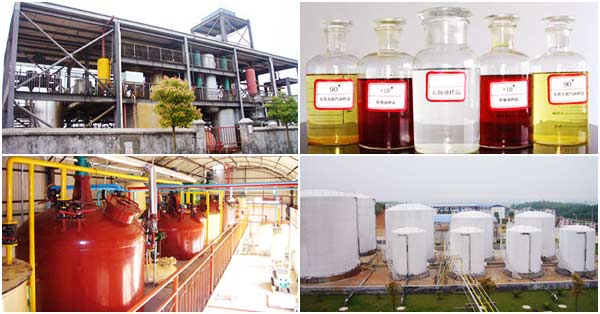Non-acid method Biodiesel Preparation Project introduction:
In order to reduce the biodiesel production process “acid residue” and “sodium waste,”, the company technical staff and experts conduct a long-term domestic oil research trials and developed a new biodiesel preparation process – Biodiesel non- acid-catalyzed production technology. The process uses a fatty acid containing a large amount of oil, under a certain pressure, temperature and special alloy catalyst pre-esterification reaction with industrial grade glycerol. Generating monoglycerides, diglycerides, triglycerides mixture.

Non-acid catalyzed biodiesel production process advantages:
1. No sulfuric participation in, it does not produce acid residue and sodium waste;
2. High concentrations of byproduct crude glycerin, which conducive distillation industrial products glycerin;
3. Do not use methyl vapor generator, which saves steam and reducing the consumption of methanol.
CONTINUOUS TRANSESTERIFICATION PROCESS
1) Transesterification
The Huatai biodiesel process uses a two-step transesterification reaction followed by neutralizing and washing steps.
The two-step transesterification reaction converts nearly 100 percent of the triglycerides in the oil or fat to biodiesel (methyl ester).
The excess methanol is recovered, and the biodiesel dried in the same step.
Finally, the biodiesel is chilled and filtered to remove potential impurities formed below the process temperature.
2) Glycerin Recovery
Glycerin generated in the two-step transesterification reaction is recovered and neutralized. The excess methanol is recovered and the glycerin dried in the same step.
The glycerin is considered a crude glycerin because it contains greater than the maximum 0.01 percent salts allowed in technical grades and is less than 99 percent pure.
The salts are formed from the reaction of the caustic and acid used in most transesterification processes. The salts are removed when the glycerin is distilled or refined to a technical grade or higher quality.
3) Water Recovery
Water recovered from the water wash decanter, strippers, and methanol distillation is reused for washing the biodiesel and diluting the acid and caustic.
4) Methanol Recovery
The excess methanol is recovered from the biodiesel, glycerin, and fatty matter, dried and reused in the two-step transesterification reaction.
5) Fatty Matter Recovery
A small amount of fatty matter, typically mono- and di-glycerides, is generated in the transesterification reaction. This fatty matter does not require a separate recovery system due to the small quantity generated, and can be skimmed or decanted from the glycerin storage tank.
If the transesterification process feedstock has a high amount of free fatty acid (FFA), then a separate fatty matter recovery step may be required.
6) Energy
The Huatai Oil Machinery design minimizes the energy required by using gravity both for separation and flow from vessel to vessel. The design incorporates heat economizers to cool one stream while heating the other.
7) Feedstock
The transesterification process is most efficient when the feedstock quality of the phosphorus and fatty acid is at least equivalent to refined and bleached (RB).
Removing the phosphorus and fatty acids is critical to producing the highest quality biodiesel for the lowest cost. Phosphorus and fatty acids form a pasty substance that inhibits the reaction rate and increases the processing cost.
OTHER HUATAI PROCESSES
For your entire Biodiesel needs, Huatai Oil Machinery designs and supplies equipment for:
Preparation
Extraction (Pressing or Solvent)
Refining
• Degumming
• Neutralizing
• Silica Adsorption and Bleaching
• Stripping and Deodorizing
Methyl Ester (Biodiesel) Transesterification
Glycerin Refining
We have more than 200 running oil processing plant around the world and have extensive experience in oil mill construction. If you are interested in our Non-acid Biodiesel Equipment, please leave us a message.

